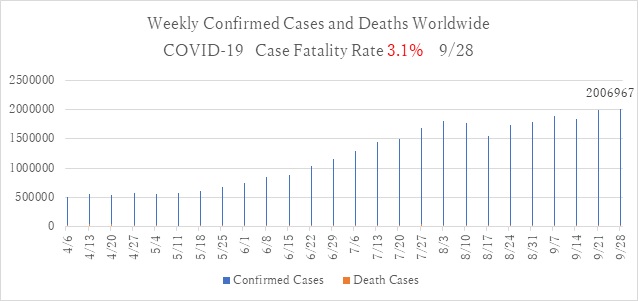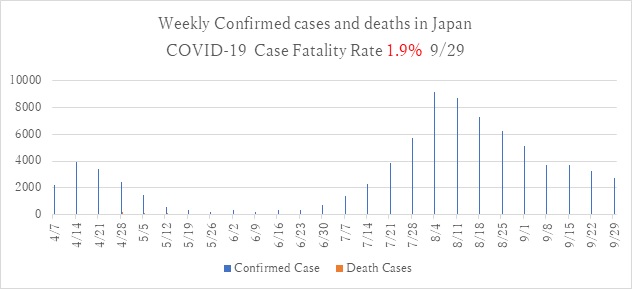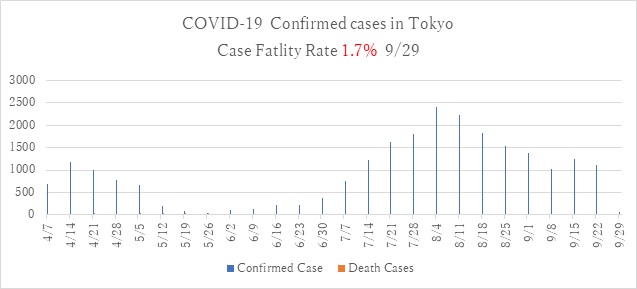SHARE
Services for the Health in Asian & African Regions (SHARE) = SHARE is a citizen sector organization (NGO) that engages in international cooperation mainly through providing health service.
HOME > News > Information of COVID-19(11)
- 【※updated】COVID-19(multi-language)
- Information of COVID-19(15)
- Information of COVID-19(vaccines)
- 《Request to the Government of Japan》Ease the protection of intellectual property rights and promote sharing and cooperating on pharmaceuticals and medical technologies, in order to accelerate efforts to overcome COVID-19 all over the world.
- Information of COVID-19(14)
- Information of COVID-19(13)
- Information of COVID-19(12)
- Information of COVID-19(11)
- SHARE Medical Information Line for Migrants is resumed in Oct.
- Information of COVID-19(10)
Information of COVID-19(11)

Information of COVID-19 (11)by SHARE 2020.10.03
1.Global and Japanese Situation of COVID-19
■Confirmed cases and new deaths from COVID-19 worldwide(source: WHO, updated 2020/9/28)Case fatality rate: 3.1%

- There is a total of 32.63 million positive cases and more than 990,000 deaths worldwide, with a case fatality rate of 3.1%. (WHO, updated 2020/9/28)
- Globally, the rate of increase for the number of new positive cases by week has remained unchanged, and the maximum peak of the increase has passed.
- In the African and Western Pacific regions, the number of cases has begun to decrease. In the European region and the Eastern Mediterranean region, the epidemic has re-emerged in September after a temporary downward trend. The number of cases in these locations is higher than in April. In the European region, France and Spain had numbers of new cases (more than 5,000 cases per day) confirmed to be larger than that during April-May. This increase can be considered as a second wave of outbreak of infection.
- In the US region, infection continues to spread.
- In the Southwest Asia region, the number of new positive cases is increasing due to an explosion of infections in India, which currently has the largest number of cases in the world, while the number of new positive cases is decreasing in other Southwest countries.
- In Southeast Asia and the Western Pacific, there have been no outbreaks reported in Thailand, Vietnam, Laos and Cambodia.
■Weekly confirmed cases and deaths of COVID-19 in Japan (updated 2020/9/28)
- Case fatality rate 1.9%

■Weekly confirmed cases of COVID-19 in Tokyo (updated 2020/9/29)
- Case fatality rate 1.7%

- In Japan, the number of new positive cases from late July to early August has been decreasing, and the overall trend is downward in the metropolitan Tokyo area and other areas. It can be said that the second wave of infection is over.
- As of September 28, fewer than 100 new cases per day have been reported in Tokyo, and more than 10 positive cases have been reported in Hokkaido, Ibaraki, Saitama, Chiba, Kanagawa, Osaka, Hyogo, Kyoto, Hiroshima, and Okinawa, although these numbers are following a decreasing trend.
- Infection is under control in the Tohoku, Hokuriku, Shikoku, and Kyushu regions.
2.Accelerating Vaccine Development, Many Questions Remain
- Vaccination is one of the most promising measures against new corona virus infections. Effective and safe vaccination may prevent serious illness and death due to infection. In addition, as with yellow fever, mandatory vaccination would allow people to return to the same international migration behavior as before the COVID-19 epidemic. This would restore the movement of people between nations, and would also provide the countries opportunities for economic recovery.
- The development of vaccines by pharmaceutical companies in Europe, the U.S., and China is progressing, and it is reported that vaccines will be approved in the near future.
- Many questions have been raised in the midst of overheated news reports on the vaccine. The first is the timing of vaccine approval. Normally, vaccine development is a time-consuming process. In the past, even the fastest approval had taken four years. However the urgent need for the vaccine has spurred development, and drug companies are spending huge amount of money to ensure that clinical trials can proceed quickly, and there are six vaccines that have begun clinical trials. The U.S. Food and Drug Administration (FDA) says any vaccine must have at least a 50 percent chance of preventing disease, which is the same effectiveness as a regular Influenza vaccine. Not all vaccine candidates will succeed to pass this standard, and there is a risk that money and manpower will be wasted on vaccines that fail.
- Another issue is fair vaccine distribution. After the vaccine is ready, the first nations in line to get it are the high-income countries that have supported the vaccine's development, such as the US and the UK. There is currently no global body to guarantee fair distribution.
- There is the possibility that all the vaccines may have side effects and that they can only provide immunity for a short period of time.
- It is worrying that governments around the world have put pressure on regulators to approve vaccines that have not been proved to be effective. On August 11st, Russia approved one vaccine before even conducting the final phase of trials that would normally be performed to prove the effectiveness of the vaccine. An ineffective vaccine even can increase the risk of larger spread of the target disease by allowing people to let them down the guard of those who receive it.
- The ultimate goal of mass vaccination is the acquisition of herd immunity. This means that a sufficient number of people must gain immunity in order to make it harder for the infection to spread. Vaccinating 70% of the population would require a large amount of funding, so this goal may not be feasible.
- Expectations for a new vaccine against the new coronavirus are high in Japan as well, but even if it is successfully developed, it is not yet known how effective the vaccine will be.
・Column: Accelerating Vaccine Development, Many Questions Remain
・Widespread anxiety over corona vaccine, world says 'I won't get vaccinated'
・Vaccine 'not to be overly hopeful'... effectiveness unknown, concerns over side effects
3.What will change under the new Japanese government's policy against COVID-19?
- On August 28, the Japanese government's task force came up with a new policy to deal with COVID-19, including a review of the testing system.
- In the past, the main route for testing was to contact consultation centers set up by public health centers and undergo testing at specialized outpatient clinics or community outpatient/testing centers set up by local medical associations, etc. In addition to this, the new plan is to test for Influenza and SARS-CoV-2 be done simultaneously at local clinics to strengthen the testing system.
- The hospitalization procedures for people with COVID-19 will also be reviewed. Specifically, those who are asymptomatic or mildly ill will not be hospitalized at medical institutions, but will be given thorough treatment at lodging facilities or at home in principle. Even up until now people with no symptoms were, in principle, required to stay at home or lodging facilities. However, there were many cases in which they were required to be hospitalized, depending on the region in which they were confirmed to be positive. The aim of this review is to reduce the number of people to be hospitalized, so that limited medical resources can be focused on the treatment of seriously ill patients and reduce the burden on local health centers that arrange patient hospitalization.
- The Ministry of Health, Labor and Welfare (MHLW) is extending the period of the "employment adjustment subsidy" from the end of September to the end of December, which started as a measure to protect employment stability. Since February this year, MHLW has been offering these special measures to companies affected by COVID-19. The maximum subsidy has been increased from 8,330 yen to 15,000 yen per person per day. The rate of subsidies for other payments such as absence allowance for employees has been increased to 75% for large companies and 100% for small and medium-sized companies.
- The Japanese government plans to downgrade COVID-19 from its current category of infectious diseases. Infectious diseases are classified as Category 1-5, with COVID-19 being classified as "Category 2 or equivalent" at present. Category 2 infectious diseases are currently identified as those needing measures such as admitting seriously ill people to hospital and advising asymptomatic people to be hospitalized, in order to isolate those who tested as positive. Under the new policy, the recommendation to admit asymptomatic and mildly ill patients is to be removed in order to ensure that beds are available for the critically ill. At present, the mildly ill are required, in principle, to be kept in isolation in an accommodation facility, but this measure will no longer be mandatory. In addition, it is likely that the accommodation for those asymptomatic and mildly ill will no longer be fully funded by the public and will require payment from those accommodated.
・What will change under the new Japanese government's policy against COVID-19?
・We need to be careful about revising the rules for COVID-19 countermeasures
・Corona "Class 2 removal" amidst the mess over Prime Minister's resignation
Written by Nakasa T, MD, Co-President of SHARE
Dr. Aya Yumino
Dr. Aya Yumino
■【Release】Information of COVID-19(ENGLISH)
■Useful URLs by multi-languages




